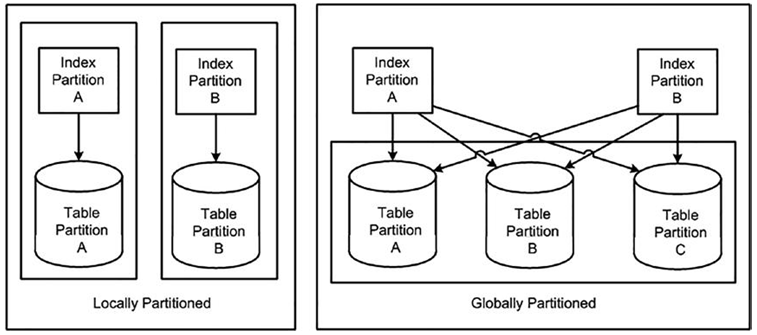Indexes, like tables, may be partitioned. There are two possible methods to partition indexes:
•\ Equipartition the index with the table: This is also known as a local index. For every table partition, there will be an index partition that indexes just that table partition. All of the entries in a given index partition point to a single table partition, and all of the rows in a single table partition are represented in a single index partition.
•\ Partition the index by range or hash: This is also known as a globally partitioned index. Here, the index is partitioned by range, or optionally by hash, and a single index partition may point to any (and all) table partitions.
Figure 13-5 demonstrates the difference between a local and a global index.
Chapter 13 Partitioning

Figure 13-5. Local and global index partitions
In the case of a globally partitioned index, note that the number of index partitions may be different from the number of table partitions.
Since global indexes may be partitioned by range or hash only, you must use local indexes if you wish to have a list or composite partitioned index. The local index will be partitioned using the same scheme as the underlying table.
Local Indexes vs. Global Indexes
In my experience, most partition implementations in data warehouse systems use local indexes. In an OLTP system, global indexes are much more common, and we’ll see why shortly. It has to do with the need to perform partition elimination on the index structures to maintain the same query response times after partitioning as before partitioning them.
Local indexes have certain properties that make them the best choice for most data warehouse implementations. They support a more available environment (less downtime), since problems will be isolated to one range or hash of data. On the other hand, since it can point to many table partitions, a global index may become a point of failure, rendering all partitions inaccessible to certain queries.
Local indexes are more flexible when it comes to partition maintenance operations. If the DBA decides to move a table partition, only the associated local index partition needs to be rebuilt or maintained. With a global index, all index partitions must be rebuilt or maintained in real time.
The same is true with sliding window implementations, where old data is aged out of the partition and new data is aged in. No local indexes will be in need of a rebuild, but all global indexes will be either rebuilt or maintained during the partition operation. In some cases, Oracle can take advantage of the fact that the index is locally partitioned with the table and will develop optimized query plans based on that. With global indexes, there is no such relationship between the index and table partitions.
Local indexes also facilitate a partition point-in-time recovery operation. If a single partition needs to be recovered to an earlier point in time than the rest of the table for some reason, all locally partitioned indexes can be recovered to that same point in time. All global indexes would need to be rebuilt on this object. This does not mean “avoid global indexes”—in fact, they are vitally important for performance reasons, as you’ll learn shortly—you just need to be aware of the implications of using them.